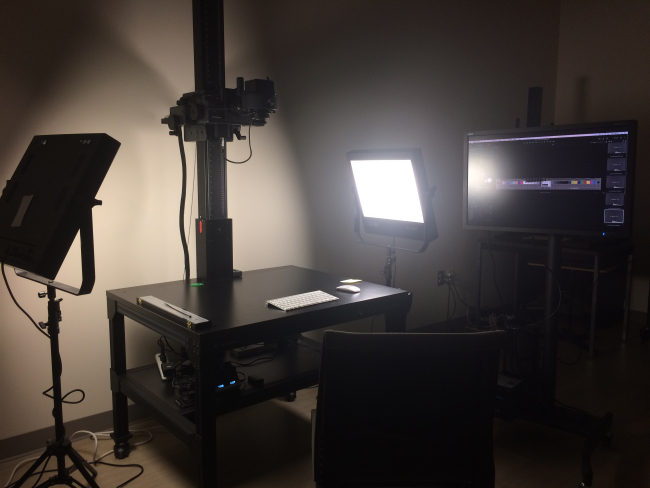
BY: CLARA AUCLAIR
In May 2017, to meet the demands for modern digital preservation standards, the River Campus Libraries and Digital Scholarship invested in a new digitization system. The University, advised by Lisa Wright, Digitization Specialist, and former director of DS, Nora Dimmock, chose the best of what the market had to offer, a camera and copy stand from Digital Transitions, a company dedicated to imaging solutions for the preservation of cultural heritage. Digital Transitions has been servicing and advising major institutions around the country, among them the Museum of Modern Art, Library of Congress, the Walt Disney Company, Google, the Smithsonian or Harvard and Yale Universities. This represented a huge step forward for Digital Scholarship, allowing us to increase our workflow while keeping up with federal digital preservation standards also known as FADGI Guidelines (Federal Agencies Digitization Guidelines Initiative).
The goal of digital preservation is to assure an accurate reproduction of an object digitally, respecting both its form and content. Indeed, there is not only a need to preserve an image of an object for its content – say the details of a letter – a lot of other information is being recorded by the camera when an image is shot at a proper resolution. The shape of an object, its paper or photographic structure, its color or its physical shape at the time of capture (to track for deteriorations, etc), among others, are valuable information for research and preservation. Imaging and preserving an object digitally does not render the need of its physical preservation obsolete. On the contrary, digital and physical preservation often goes hand in hand: having an image of an asset provides a good record in the event of physical deterioration and loss but also allows for an easier access and less manipulation if an object is consulted frequently by researchers. On the other hand, a digital image of an object never entirely replaces the object itself – research can and will always benefit from the encounter with its materiality, which must therefore be preserved.
Digital Scholarship works with River Campus Libraries, Faculty and Students on different projects involving different type of imaging needs. We work closely with Rare Books and Special Collections, for example, on digital preservation projects, such as imaging parts of the Beecher Hooker Collection that has been made accessible online in March 2018. The lab is also involved with projects such as ReEnvisoning Japan with Professor Joanne Bernardi and works with other professors and their classes to provide images of rare and fragile documents for research and transcription projects. We recently digitized the first volume of the Lewis Henry Morgan manuscript journals for Professor Robert Foster's Research Colloquium celebrating the bicentennial of Rochester's anthropologist LH Morgan. Because the journal is an extremely rare and fragile document, difficult to manipulate, Professor Foster collaborated with us and we were able to provide the class with digital reproductions of the journal pages, allowing students easier access to the text for their transcription project. Digitizing the Morgan journal was one of the most challenging project we had to work with so far and its intricate process will be the object of another blog post so keep posted!
We were extremely excited last May when we received the camera and when Digital Transitions came to install our new reprographic system. We couldn't wait to see what we would achieve with a camera equipped with a 100mp sensor and 72mm lens – a lot of work was still ahead of us though, as we needed to receive proper training to get acquainted with the equipment, its corresponding software and set new standards for our lab.

Lisa Wright and I received three days of training to get introduced with the basic functions of the camera and Capture One CH, the imaging software that works with it. We couldn't emphasize enough how much team work is important when tackling highly technical trainings with so many new procedures to learn, we were happy to be able to help each other along the way! Capture One Cultural Heritage is an imaging and editing software similar to Lightroom (Adobe Creative Suite), a software we were previously using with our former reprographic system. However, Capture One CH has been specifically designed to answer the needs of imaging for cultural heritage. It works with an entirely different interface which allows for more flexibility and quality control over the images we create, as well as a stronger library for storing and uploading our work with RCL's different departments. One of the features we were the most excited about was the auto-straightening and auto-cropping, which promised to dramatically improve our post production workflow.
Because the software comes with a limited user's manual, we had to create our own in the weeks following training, to assure that knowledge acquired wasn't lost and that we could train more staff members in the future. We didn't have much to work from but were therefore able to tailor our manual to our specific needs and workflow. This meant a lot of trial and errors but also ensuring more sustainability for the future of the lab. Our goal is to create as much resources as possible as we learn, so work could be picked up by a new staff member, and the equipment used to its best ability throughout the years. As of today, our manual consists of a shared word document, which every staff member is able to update as we learn new features or establish new standards. We make a point of including a lot of screen captures to help with different explanation stages and keep a trace of our settings. This is a work in progress and we would like to convert this work into a Wiki page to make it even more user friendly and accessible, while possibly making the resource we create available to a larger community, of other university labs or museums working with similar set ups.


